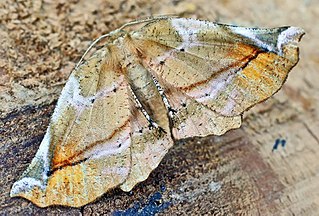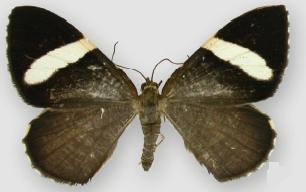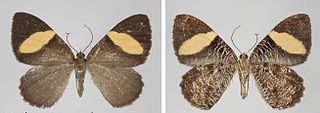
Apamea crenata, known as the clouded-bordered brindle, is a moth in the Noctuidae family. It is distributed throughout the Palearctic realm.

Colotis fausta, the large salmon Arab, is a small butterfly of the family Pieridae, that is, the yellows and whites, which is found in Israel, Syria, Turkey, Iran, Afghanistan, Turkmenistan, India, Arabia, Chad, Somalia and United Arab Emirates.

Arhopala abseus, the aberrant oakblue or aberrant bushblue, is a species of lycaenid or blue butterfly found in Asia.

Apeira syringaria, the lilac beauty, is a moth of the family Geometridae. It is found throughout Europe and east across the Palearctic to the Russian Far East and Japan.

Plemyria rubiginata, the blue-bordered carpet, is a moth of the family Geometridae found in Europe and across the Palearctic. The moth was first described by the Austrian lepidopterists Michael Denis and Ignaz Schiffermüller in 1775.

Catarhoe cuculata, the royal mantle, is a moth of the family Geometridae. The species was first described by Johann Siegfried Hufnagel in 1767. It is found from Europe to western Central Asia and east Siberia. The species prefers to live in light forests and forest edges, but also occurs on meadows.
Tasmantrix thula is a moth of the family Micropterigidae. It is known from eastern Australia, where it is known from northern Queensland, from Devils Thumb and Mossman Gorge in the north to Mission Beach and from Herberton State Forest to Mission beach.

Hagnagora elianne is a species of moth of the family Geometridae first described by J. Bolling Sullivan in 2011. It is found in Costa Rica and Honduras.

Hagnagora unnia is a species of moth of the family Geometridae first described by J. Bolling Sullivan in 2011. It is found in Costa Rica.
Habrona marmorata is a moth in the family Drepanidae. It is widely distributed in Papua and Papua New Guinea.

Lacinipolia dimocki is a moth in the family Noctuidae. It is found on the eastern slope of the Washington Coast Ranges to southern California.

Hagnagora buckleyi is a species of moth of the family Geometridae first described by Herbert Druce in 1885. It is found in north-western Ecuador. It is named for the botanist Samuel Botsford Buckley.

Hagnagora marionae is a species of moth of the family Geometridae first described by Gunnar Brehm and J. Bolling Sullivan in 2005. It has been collected only at two high mountain areas in Costa Rica at elevations above 2,500 metres (8,200 ft).

Hagnagora richardi is a species of moth of the family Geometridae first described by Gunnar Brehm in 2015. It is only known from a small region around Podocarpus National Park in Zamora-Chinchipe and Loja provinces in Ecuador.

Hagnagora hedwigae is a species of moth of the family Geometridae first described by Gunnar Brehm in 2015. It is only known from southern Ecuador.

Hagnagora croceitincta is a species of moth of the family Geometridae first described by Paul Dognin in 1892. It is found from central Colombia to south-eastern Peru.

Hagnagora clustimena is a species of moth of the family Geometridae first described by Herbert Druce in 1893. It is found in Mexico, Panama, Honduras and Costa Rica.

Hagnagora mortipax is a species of moth of the family Geometridae first described by Arthur Gardiner Butler in 1872. It is found in Costa Rica and Ecuador.

Hagnagora subrosea is a species of moth of the family Geometridae first described by William Warren in 1909. It is found in Peru.

"Hagnagora" vittata is a species of moth of the family Geometridae first described by Philippi in 1859. It is found in Chile.

















